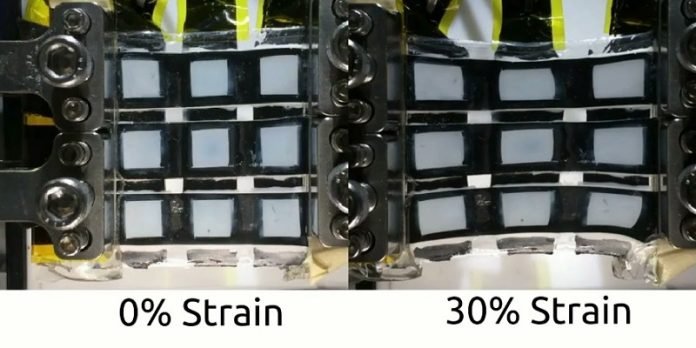
Imagine a world where wearable patches can monitor your health through color changes or shipping labels can indicate the temperature or sterility of food items using light.
This future may be closer than you think, thanks to a groundbreaking invention by researchers at the University of British Columbia (UBC).
They have developed a flexible display that can stretch, change colors, and offer real-time visual feedback, opening up a world of exciting possibilities.
The device, created by Claire Preston as part of her master’s program in electrical and computer engineering, boasts impressive features.
It can stretch up to 30% without losing performance, making it highly durable.
Its color-changing technology allows for fast and reversible color change, making it suitable for visual monitoring. And the best part? It’s relatively inexpensive to manufacture.
Unlike previous attempts at creating stretchable displays, which involved complex designs and materials, the UBC researchers used electrochromic displays.
These displays can change color in a reversible manner while consuming low amounts of power, overcoming previous limitations.
The team utilized a material called PEDOT:PSS, which combines a conductive polymer with an ionic liquid.
This combination serves as a stretchable electrode, functioning as both the electrochromic element and the ion storage layer. This simplified the device’s structure and eliminated the need for a separate stretchable conductor.
The resulting display is transparent and feels similar to a stiff rubber band.
To ensure its durability, the researchers added a solid polymer electrolyte and a stretchable encapsulation material called SEBS, allowing the thin layers of PEDOT to elongate without breaking.
The potential applications for this stretchable display are vast. It could be integrated into wearable devices for monitoring vital signs, providing real-time visual feedback on health indicators.
In the realm of robotics, the displays could be used as “skin” for robots, enabling them to display information and interact more intuitively with humans.
The technology’s low power consumption and cost-effectiveness make it appealing for disposable applications as well. It could be used in indicator patches for medical purposes, where it changes color to show specific conditions.
Additionally, it could find use in smart packaging labels for sensitive shipments or as a way to actively change the color of clothing items like jackets and hats.
While further work is needed to integrate this device into everyday products, this breakthrough brings us closer to a future where flexible and stretchable displays are commonplace in our daily lives.
The possibilities are limitless, and we are on the cusp of experiencing a revolution in wearable technology and visual communication.
The study was published in ACS Applied Materials & Interfaces.
Follow us on Twitter for more articles about this topic.



